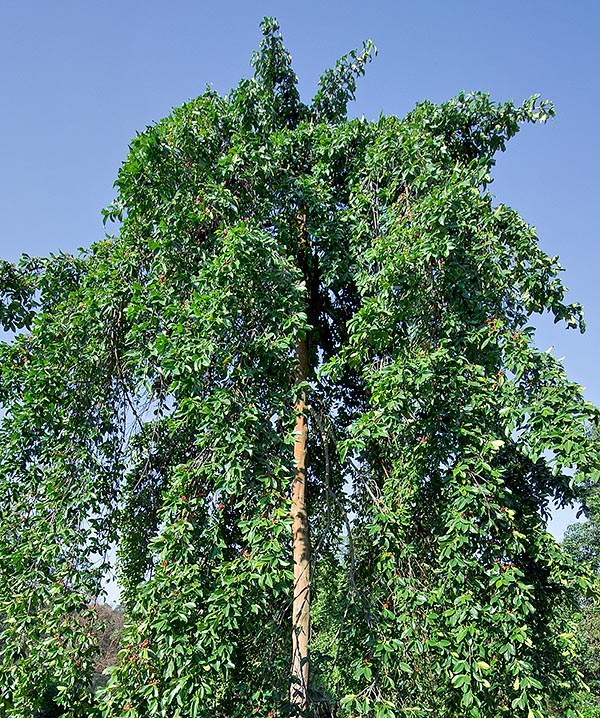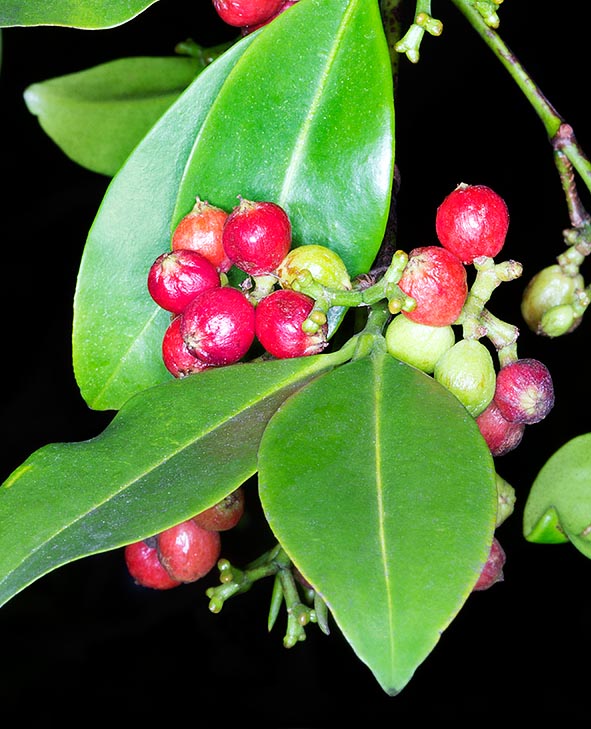Family : Rhizophoraceae

Text © Pietro Puccio

English translation by Mario Beltramini

Carallia brachiata is a very ramified evergreen tree that may be 30 m tall close to water streams in the humid, often swampy, forests going from Madagascar to India up to beyond Australia © G. Mazza
The species is native to Australia (Northern Territory, Queensland and Western Australia), Bhutan, Cambodia, China (Fujian, Guangdong, S Guangxi, Hainan and Yunnan), India, Indonesia, Laos, Madagascar, Malaysia, Myanmar, Nepal, New Guinea, Philippines, Salomon Islands, Thailand and Vietnam where it lives in the humid forests, often close to swamps and water streams, from the sea level up to about 1500 m of altitude.
The name of the genus comes from “karalli”, given to a specie belonging to the genus in Telugu language; the specific name is the Latin adjective “brachiatus, a, um” = ramified.
Common names: corkwood, corkybark, freshwater mangrove (English); kanthekera (Assamese); kierpa (Bengali); maniauga (Burmese); ngo shen muk, nik nga tsai (Chinese); dom-trameng, tromeng (Khmer); bong nang, halay (Lao); varanga (Malayalam); kesinga, meransi, sisek puyu (Malay); amparimamy, farimamy (Malagasy); panasi (Marathi); kathe kera (Nepali); anosep, bakawan gubat, bakhaw bukid, malabakhaw, sigiran (Tagalog); chiang phra nang ae, to sai (Thai).
The Carallia brachiata (Lour.) Merr. (1919) is a very ramified evergreen tree, 10-30 m tall and with cylindrical trunk of 25-50 cm of diameter at the base, with greyish bark from smooth, in the young specimens, to fissured in the older ones.
The leaves, on an about 1 cm long petiole, are simple, opposite, obovate-oblong with pointed apex and entire margin or at times slightly serrate, 6-15 cm long and 2-8 cm broad, coriaceous, of green colour, glossy above; stipules (appendages at the base of the leaf that have the main task to protect it during the initial phase of growth) lanceolate, deciduous, 1,5-2 cm long.

The fruits, edible, are 0,5-0,8 cm globose berries. Leaves and bark are used in traditional medicine © Giuseppe Mazza
The fruits, edible, are globose berries, of 0,5-0,8 cm of diameter, pink to red when ripe, glossy, containing 1(-5) reniform seeds.
It propagates by seed, to be interred in short times having a short lasting germinability, in draining organic loam maintained humid at the temperature of 24-26 °C, with times of germination of 1-3 months, by apical cutting and root suckers. Species cultivable in the tropical and humid subtropical climate zones in full sun, except for the initial phase of growth when a slight shade is useful, in soils maintained constantly humid, being rather sensitive to the drought. It has a limited use as ornamental, in particular the variety ‘Honiara’ with drooping branches (see photo), utilized as isolated specimen or in group in parks and gardens and as road tree, where it has proven resistant to the urban pollution.
The wood, of good quality, easy to work and to finish, but poorly resistant to the atmospheric agents, is utilized for inner parts in the constructions of dwellings, for furniture, tools, musical instruments, artistic objects and handicrafts, is also excellent as firewood and for the production of charcoal.
Leaves and bark are utilized in the traditional medicine, especially in mouth and throat diseases.
Synonyms: Diatoma brachiata Lour. (1790); Barraldeia madagascariensis DC. (1824); Carallia integerrima DC. (1828); Petalotoma brachiata (Lour.) DC. (1828); Carallia baraldeia Arn. (1838); Carallia sinensis Arn. (1838); Eugenia cupulifera H. Perrier (1952); Carallia madagascariensis (DC.) Tul. (1856).
→ To appreciate the biodiversity within RHIZOPHORACEAE family please click here.
